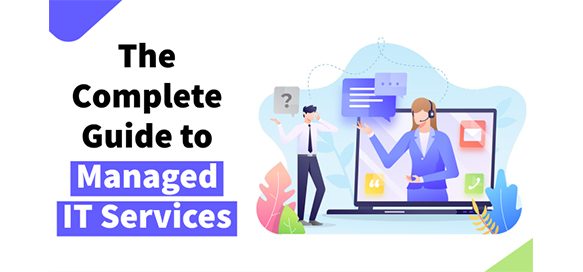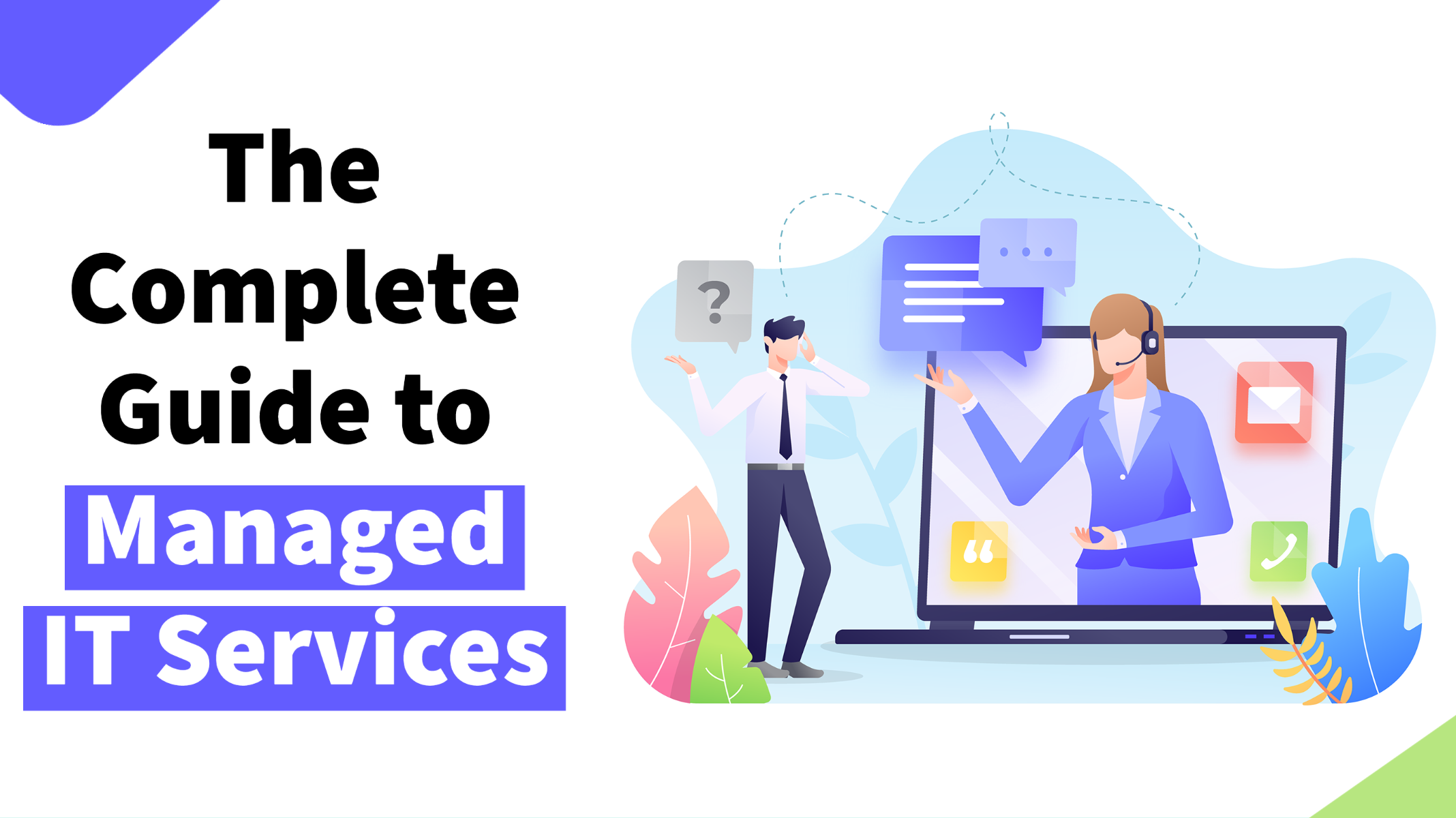
The demand for managed IT services has been growing at a steady pace, and the global managed services market is expected to reach $329 billion by 2025.
While virtually all modern organizations have complex IT needs that need to be supported on a regular basis, they don’t always have the resources to do so themselves. That’s where managed IT services providers come in, offering a cost-effective alternative to in-house IT management.
Our complete guide to managed IT services is intended for those who are considering this approach to IT but don’t know what outsourcing the responsibility for maintaining daily IT operations entails.
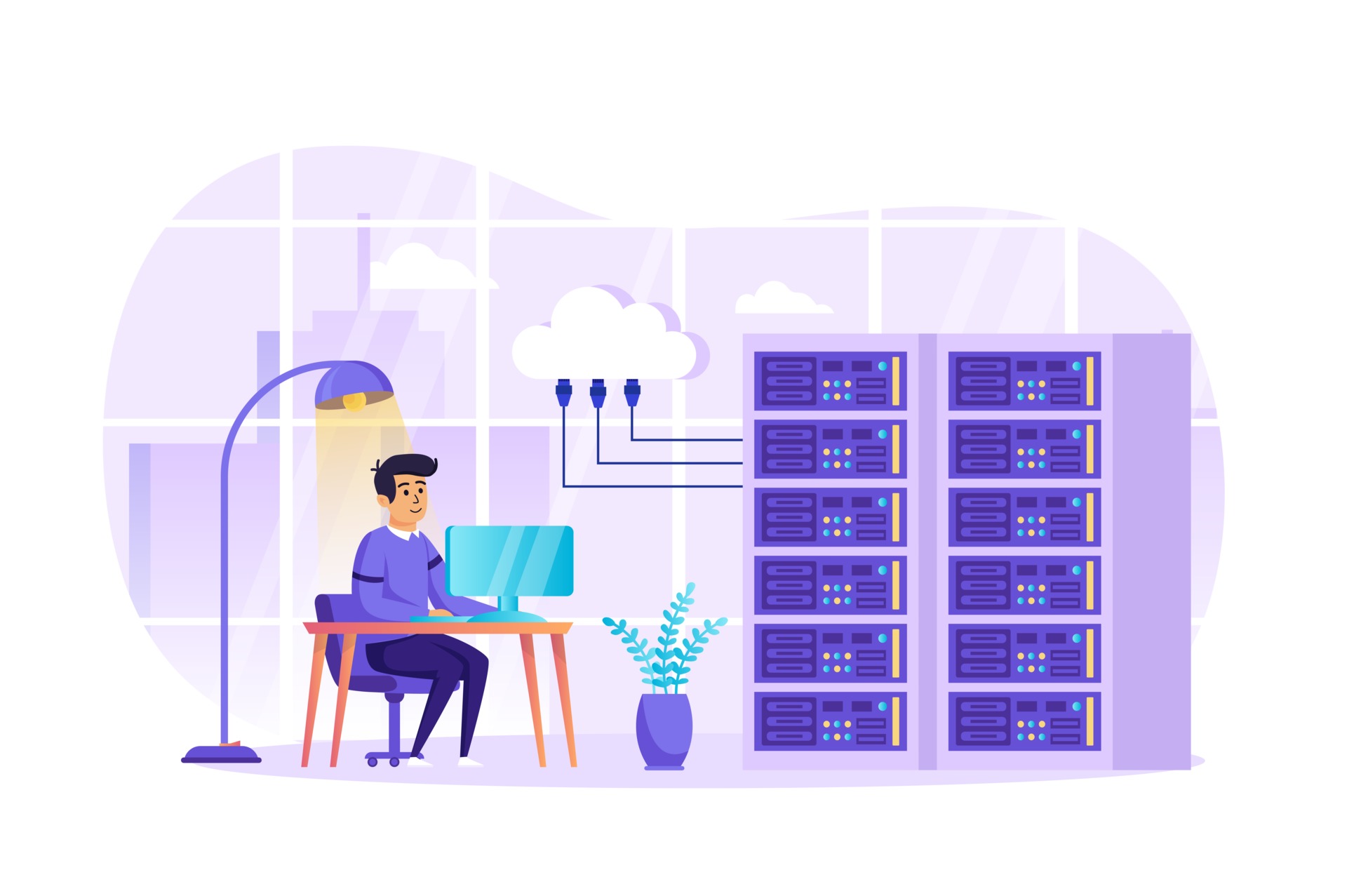
What Are Managed IT Services?
According to Gartner’s Glossary of Information Technology, a managed IT services provider (MSP) delivers “services, such as network, application, infrastructure and security, via ongoing and regular support and active administration on customers’ premises, in their MSP’s data center (hosting), or in a third-party data center.”
Basically, MSPs provide a proactive alternative to the traditional break-fix service model, which boils down to organizations calling in an IT professional to solve problems as they occur and paying only for services actually rendered.
Because the break-fix service model is reactive, it doesn’t meet the expectations of modern organizations, which heavily depend on their IT infrastructure and want to eliminate downtime caused by issues with it as much as possible.
Whereas large enterprises with plenty of resources can overcome the limitations of the break-fix service model by hiring in-house IT staff, small and medium-sized organizations (SMBs) can seldom afford to do so—at least not without experiencing a major financial burden.
Managed IT services make it easy for organizations of all sizes to keep their infrastructure in top shape and prevent—rather than react to—problems long before they happen. They also provide access to best-in-class technology and skilled professionals without requiring any upfront investment whatsoever.
Types of Managed IT Services
The IT industry is vast and includes a huge array of technologies and solutions. As such, there are many different types of managed IT services, some offering all the services described below, while others are specializing in just one or two.
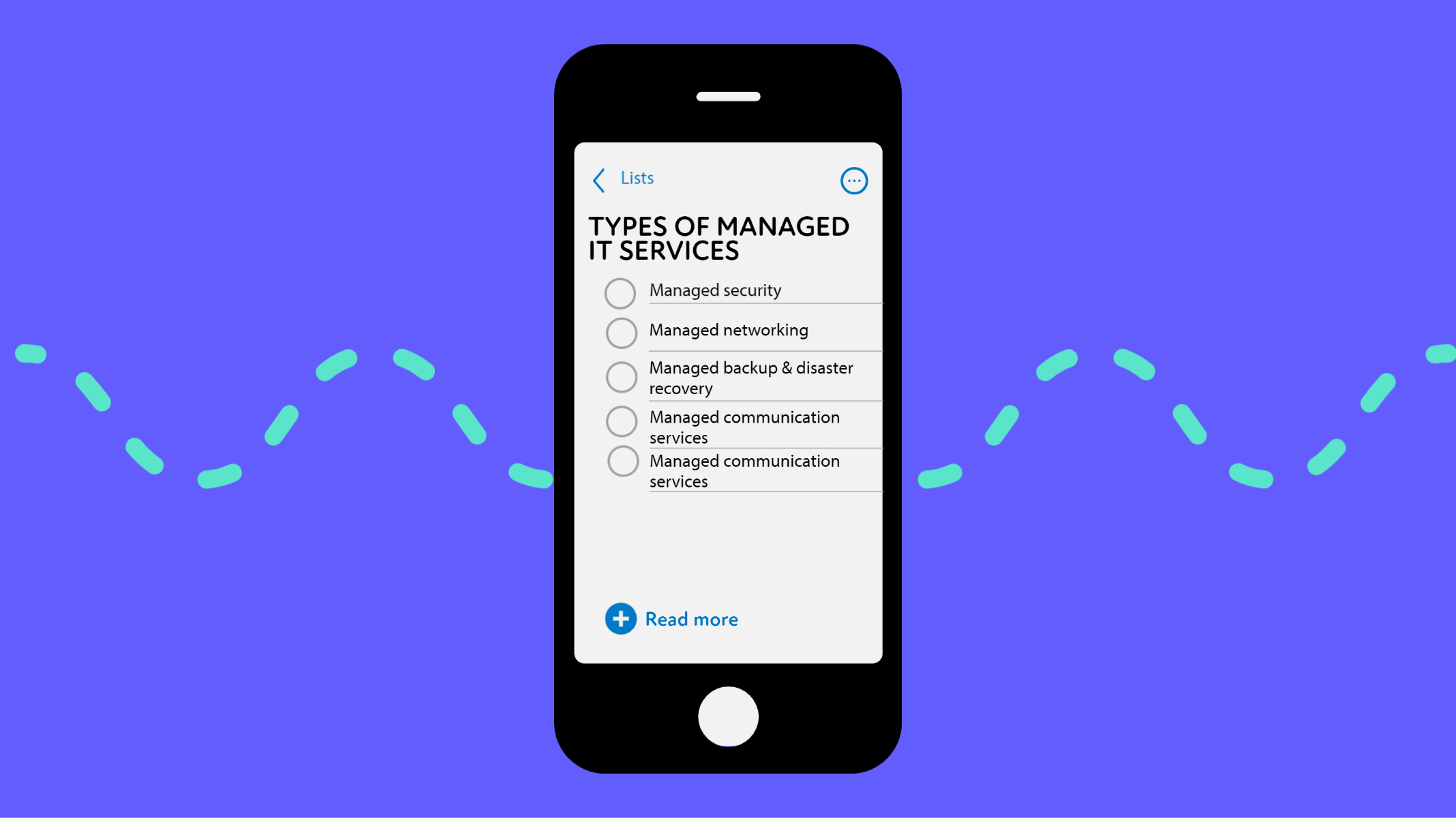
Managed security
Perhaps the most popular type of managed IT services, managed security services (MSS) address the growing need of organizations across all industries to protect sensitive data and critical infrastructure against cybercriminals using technologies such as firewalls, anti-malware software, network monitoring, and others.
Managed networking
To ensure seamless collaboration and uninterrupted flow of information, organizations need robust networks consisting of servers, switches, wireless access points, and other essential components. MSPs that specialize in networking can handle not only the initial on-site infrastructure setup but also its ongoing management.
Managed backup and disaster recovery
Data loss can occur for many different reasons, including natural disasters, human errors, hardware failures, or data breaches. Managed backup and disaster recovery services help organizations back up all important data in a safe location (or multiple locations) and quickly recover it when needed.

Managed communication services
Being able to effectively communicate with customers and business partners is essential for nurturing long-lasting partnerships, and the same communication tools, such as VoIP and instant messaging, can also help employees collaborate better.
Managed support services
No complex software application is free of bugs, and no hardware is completely reliable, so it’s only a matter of time before employees experience a problem they won’t be able to solve on their own. Managed support services can be on-site or remote, but they share the common goal of solving technical issues as quickly as possible to minimize downtime.
For more information about the different IT services offered by MSPs and their pricing, we recommend you read this article.
Pros and Cons of Managed IT Services
Managed IT services are just one of several approaches organizations can choose from in order to meet their information technology needs. Because there’s no such thing as a one-size-fits-all approach, you need to carefully consider the pros and cons of managed IT services to determine whether partnering with an MSP is the best course of action for you.
Pros
The pros of managed IT services stem predominantly from their predictable cost, hands-off nature, and ability to provide what’s essentially a complete IT department without any of the headaches and financial difficulties associated with creating one from scratch.
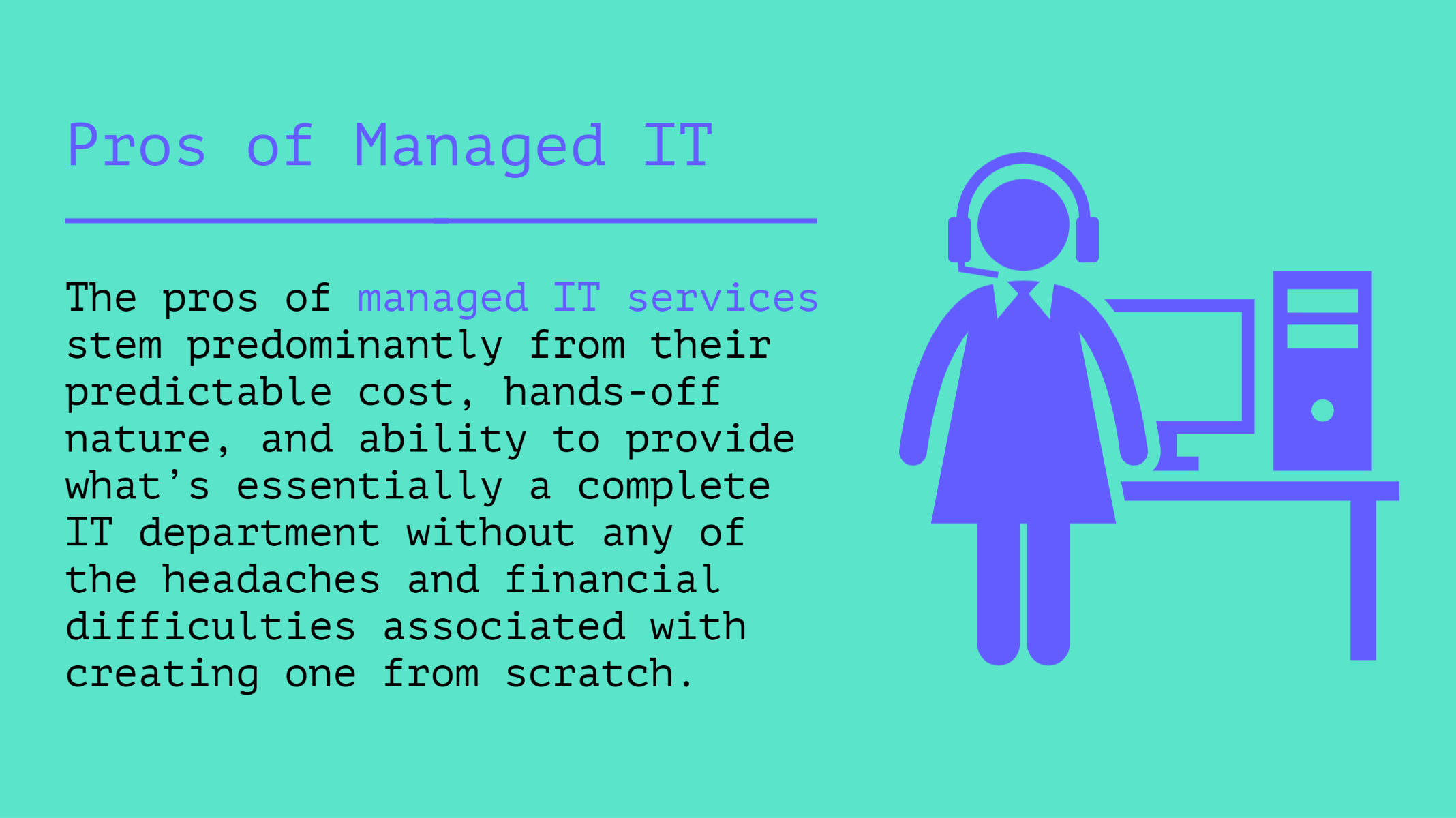
Improved focus on core business competencies
Your organization can’t afford to be a jack of all trades but a master of none. Trying to maintain focus on core business competencies while managing your IT infrastructure is an extremely difficult task that rarely ends well. By choosing managed IT services, you can focus your undivided attention on what you do best and let skilled IT professionals proactively manage your infrastructure for you.
Reduced total IT costs
The salaries of full-time IT employees are just one of many expenses organizations that decide to take care of their IT in-house need to worry about. An MSP can provide access to top IT talent at a fixed monthly price and without any upfront investment required. Additional money can be saved on equipment and office space, neither of which is required when a third party is responsible for your information technology needs.

Access to expert skills and state-of-the-art technology
The current tech talent shortage has made it difficult for many organizations with in-house IT teams to scale up and implement the technology they need to be productive and competitive. In contrast, those who rely on managed IT services are unaffected by it thanks to economies of scale and their ability to attract top talent and provide access to state-of-the-art technology at an affordable rate.
Improved security and compliance
Long gone are the days when only large enterprises attracted the attention of cybercriminals while SMBs comfortably flew under the radar. These days, security and compliance with increasingly stringent data protection regulations need to be every organization’s top priority. Many managed IT services offer enterprise-grade cybersecurity solutions designed for small to medium-sized organizations to keep all common and not-so-common threats at bay, including social engineering attacks, ransomware, and insider attacks.
Enhanced scalability and flexibility
Technology evolves at a rapid pace, and so does the world of business. It’s entirely possible that your current IT infrastructure will have very little in common with the infrastructure you’ll depend on two years from now. Unlike the in-house IT model, managed IT services are scalable and flexible, and they can be quickly aligned with changing business conditions, making them a great choice for all organizations that value agility.
Cons
On the other hand, the cons of managed IT services have all something to do with their remote nature, highlighting the importance of choosing a local provider that can arrive at your location in a short amount of time to address problems that can’t be troubleshooted and fixed remotely. What’s more, a local MSP will better understand the market you operate in and the needs of your customers.
Lack of physical presence
Having someone right next door when a router decides to stop working or an essential business application becomes inaccessible is not only convenient but also reassuring. Like we already said, choosing a local MSP is a good compromise between the convenience of an in-house IT team and the numerous benefits associated with outsourcing to a third-party provider, but don’t expect your local MSP to arrive at your location in a few short minutes. Even if you choose a highly responsive MSP that’s located very close to you, it will likely take up to an hour for you to receive assistance during normal operating hours.
Reduced synergy between business and IT
Because MSPs are responsible for multiple customers, they don’t have the same deep understanding of each customer’s IT infrastructure, business needs, and specific industry as an in-house IT team does, resulting in reduced synergy between business and IT. This downside is largely negated by the fact that MSPs provide access to experienced IT professionals and best-in-class technology solutions, which might not otherwise be available to smaller organizations.
How to Choose a Managed IT Services Provider?
Choosing a managed IT services provider can be a daunting task because there’s a lot of trust involved.

A partnership with a capable MSP that is always eager to go the extra mile to help your organization thrive can be just what you need to achieve your business objectives and make you a leader in your industry. In contrast, a partnership with an MSP that’s interested only in its bottom line can drag you down like the ball and chain.
Here are some selection criteria that you should always keep in mind when deciding between multiple MSPs.
Technology skills and experience
You wouldn’t hire an IT professional who can barely get a printer working or troubleshoot basic operating system errors, so you definitely should avoid MSPs that don’t have in-depth experience working in your particular industry, helping their customers take advantage of the latest technologies.
An experienced MSP will be able to anticipate potential problems a long time before they actually occur. In situations when problems occur unexpectedly, an MSP with many years of relevant experience will be able to react quickly and choose the best solution available right on the first try, minimizing your downtime and the financial loss associated with it.
Alignment with industry best practices and standards
Depending on the industry you operate in, you might need to adhere to certain best practices and standards, such as the National Institute of Standards & Technology (NIST) Cyber Security Framework (CSF), the Payment Card Industry Data Security Standard (PCI DSS), the Health Insurance Portability and Accountability Act of 1996 (HIPAA), or the Cybersecurity Maturity Model Certification (CMMC).
To achieve and maintain compliance with them, it’s paramount to choose an MSP that understands their key requirements and knows what steps must be taken to satisfy them. The MSP itself must have an outstanding security record and actively seek out cutting-edge solutions from which its customers could benefit.
Local presence and around-the-clock availability
In this complete guide to managed IT services, we have stressed the importance of partnering with a local managed IT services provider several times already, but now is a good time to discuss it one last time. A local MSP will be able to offer personalized solutions based on the needs of organizations operating in an area the provider is deeply familiar with. Should something go wrong with them, hands-on assistance will be just a short distance away.
Because servers, unlike human beings, don’t go to sleep, it’s always best to choose a local provider that’s available to you 24 hours a day, seven days a week, 365 days a year. That way, troubleshooting can begin without any delay, and downtime can be minimized as much as possible.
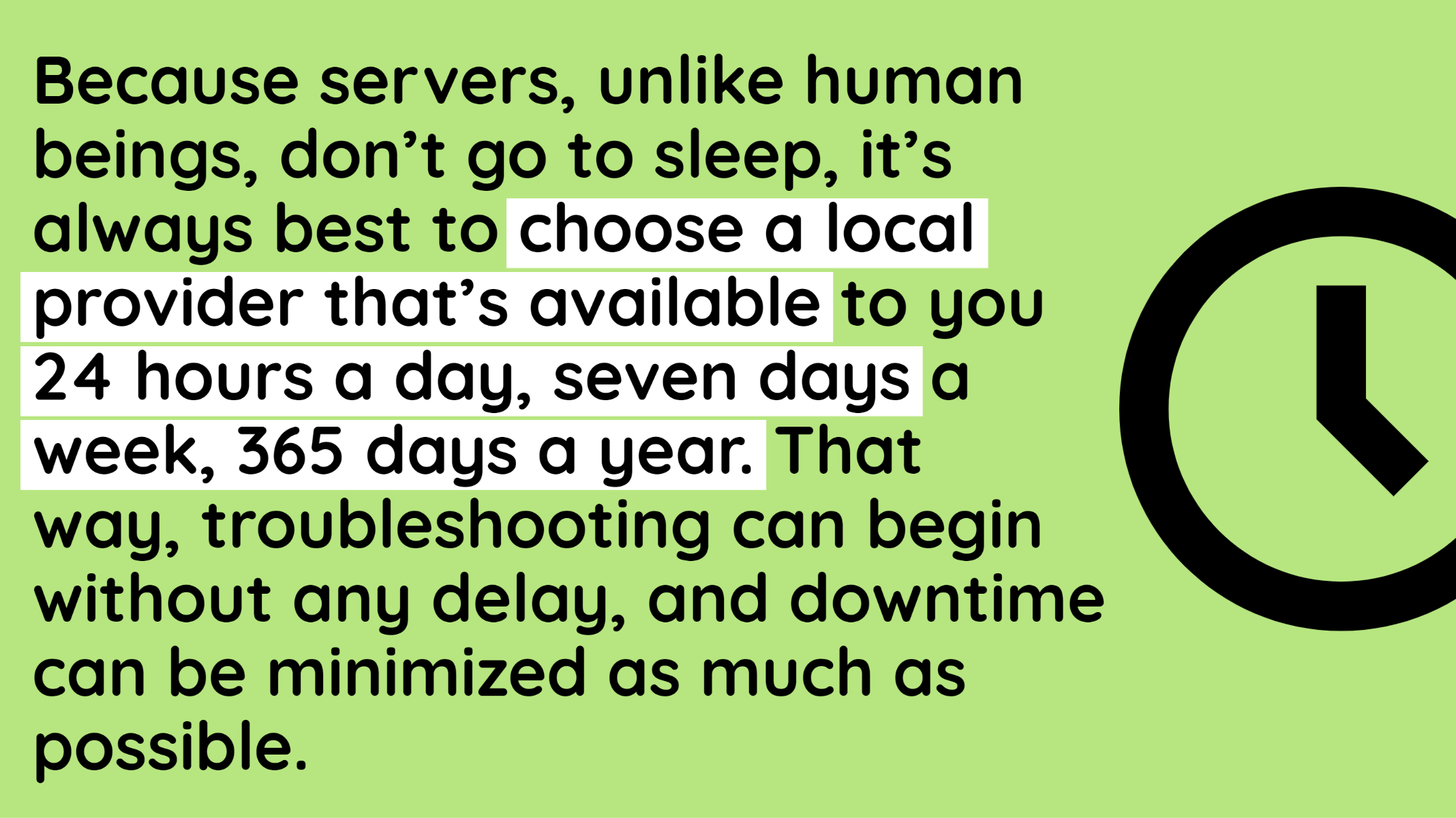
Great communication skills
Communication is essential for all relationships, and the relationships organizations have with their managed IT services providers are no exception. In fact, all MSPs need to have great communication skills to understand their customers’ needs and discuss the implementation of solutions capable of effectively addressing them.
Your MSP should be willing to have face-to-face or virtual meetings with you on a regular basis so that you can review your current IT environment and plan technology investments in order to improve it. If you stumble upon an MSP whose time is too precious to communicate with you regularly, then we highly recommend you stay away and find someone else.
References and reputation
It goes without saying that you want to partner with an MSP that has excellent references and a stellar reputation. A simple online search should lead you to at least some verified reviews from real customers with a similar number of employees as you have. If you’re willing to take your research a step further, you can get in touch with some reviewers on LinkedIn and ask them a few questions about the MSP.
It’s also a good idea to check how long the MSP has been in business and whether they have any debt or other financial issues. If you decide to schedule a meeting, ask if you can visit their offices and see how they operate. Are they willing to show you everything? Are employees at all levels friendly and helpful? If so, then it’s likely that you’ve found a good match.
Summary
Managed IT services offer an attractive alternative to in-house IT support, whose advantages include an instant cost reduction, enhanced productivity, access to top talent and technology, as well as improved scalability. This proactive alternative to the traditional break-fix service model is especially suitable for smaller organizations with limited resources. To be competitive, such organizations need a robust IT environment that can help them achieve their business goals—however modest or grandiose they may be.
At BCA, we provide managed IT services in Miami, Orlando, & Tampa, FL to small and medium-sized businesses. Our services encompass everything from cybersecurity to data backup and disaster recovery to communications. During operating hours, we can provide assistance within one hour from the initial contact, and all of our technicians are certified and receive ongoing training to stay up to date with the latest technology.
If you think that we at BCA could be the right managed IT services provider for your organization, contact us today.

